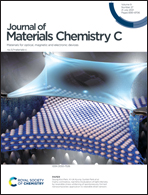A broadband optical pH sensor using upconversion luminescence†
Abstract
Determination of the pH value of a medium without the usage of less photostable and toxic dye molecules or dye incorporated particles still remains a challenging task. Here, we demonstrate that the upconversion luminescence of an optically trapped upconversion particle offers a rapid approach for the quantitative estimation of the surrounding pH value. Microwave synthesized polyethyleneimine (PEI) capped NaYF4:Yb,Er is optically arrested in a medium of interest using a home-built optical trap set up with a 1064 nm diode laser as the trapping source. The upconversion luminescence spectrum emanating from the optically trapped particles is recorded upon 980 nm laser excitation. Aside from manifesting additional emission peaks in the upconversion luminescence as compared to the bulk solution, an excitation laser power-dependent study reveals that upconversion luminescence emission from an optically trapped particle follows a two-photon process. The linear change in the ratio of red to green emission with an increase in the pH value of the surrounding medium from 1 to 14 indicates that the upconversion luminescence from an optically trapped particle can be used as a pH probe of the surrounding medium in the range 1–10. The emission measurements from an optically trapped particle were repeated in different buffers and it was confirmed that the particle retained its emission characteristics. The X-ray photoelectron spectroscopic studies show that the upconversion particles are stable even after being kept in buffer solutions with different pH values (1 to 14) for 48 hours. Furthermore, by changing the pH value of the surrounding medium of an optically trapped particle inside a microfluidic channel, the feasibility of the developed pH probe for rapid measurements is demonstrated. The developed near-infrared emission excitation assisted single upconversion particle pH probe can find diverse applications, particularly in a biological environment and in cellular pH probing. In addition, the potential of an optically trapped particle to monitor the surrounding temperature was also demonstrated.



 Please wait while we load your content...
Please wait while we load your content...